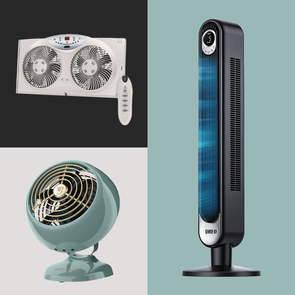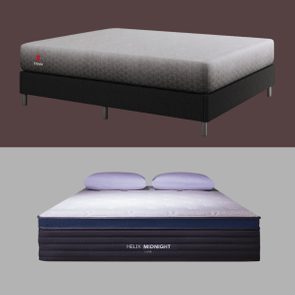Hands Off: 5 Everyday Things That Get Dangerously Hot in Extreme Heat
Updated: Jan. 25, 2024
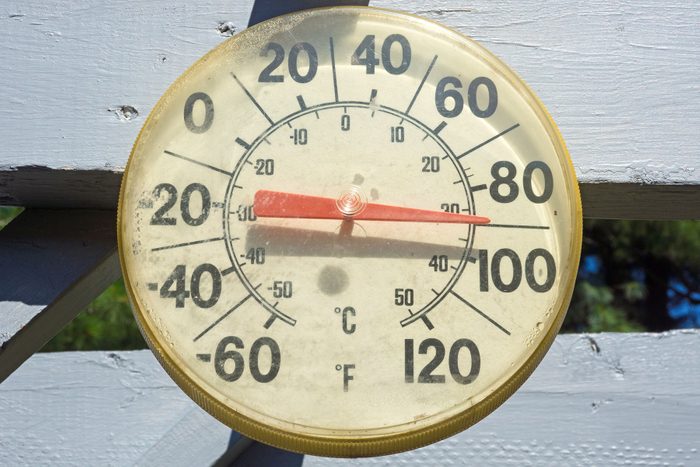
Just how hot can everyday objects get during a heat wave? And how can you protect yourself? Here's what the experts say.
It isn’t just hot—it’s blazing hot. This month, the United States reached record-high temperatures, with 42 million Americans affected by major heat waves. It’s a problem globally this summer too: The week of July 3 broke heat index records with four straight days of sweltering conditions around the world.
Global warming plays a major role, causing heat waves to be more intense and more likely. A rise in ocean temps is also contributing to the soaring humidity levels and heat waves on land. “Studies of other recent heat waves, such as the extreme heat in the Pacific Northwest in 2021 and the unusual early season heat in Spain and Portugal this year, found that they were made much more likely by the effects of increasing greenhouse gases,” says Anthony J. Broccoli, a professor of atmospheric sciences at Rutgers University and co-director of the Rutgers Climate Institute.
We know the air is hot, but what about the everyday things we interact with? As the temps continue to soar (the forecast is set to get worse this summer), be cautious of certain heat conductors you use daily. “Anything that can absorb sunlight on a hot day could become dangerous to touch because it can reach temperatures that are higher than the air,” Broccoli says. Don’t get unintentionally scorched by these everyday items.
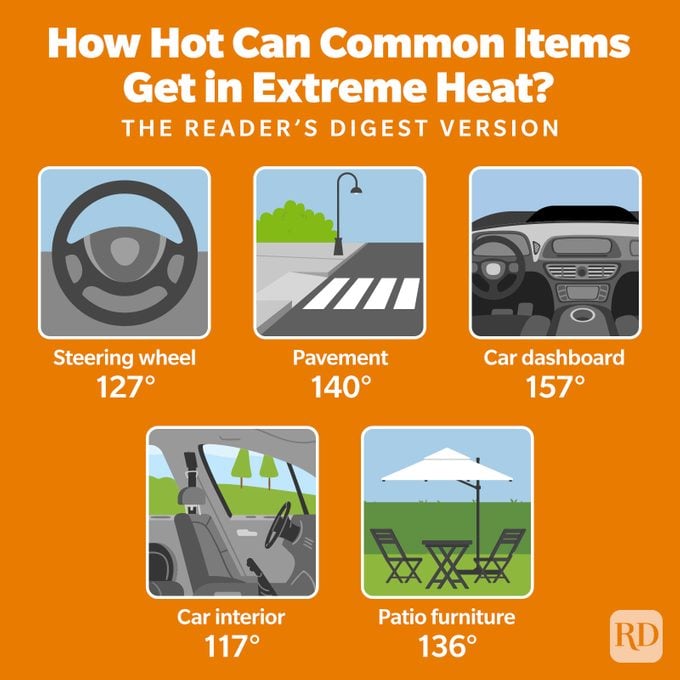
Get Reader’s Digest’s Read Up newsletter for more summer tips, humor, cleaning, travel, tech and fun facts all week long.
Caution! These items are hot
Pavement

Whether it’s a sidewalk, driveway or road, pavement easily soaks up heat and gets incredibly hot in the summertime. At midday—anywhere from 12 p.m. to 4 p.m.—a blacktop can get as hot as 140 degrees during extreme temperatures. To put that into perspective: Humans begin to feel pain at a temperature of 111 degrees (hot bathwater). But according to the National Institute for Standards and Technology, at 118 degrees, you can sustain first-degree burns, while second-degree burns can come at 130 degrees. So if your feet (or your pet’s feet!) are not protected, you could be chicken dancing across the blacktop to the emergency room.
Railings
Metal in the baking sun? Whether the railings are made from aluminum, copper, iron or a similar material, metal is a heat conductor, and it will get just as hot as the temperature coming from its heat source—in this case, the sun. While a railing won’t get as hot as, say, a frying pan on a stove (which reaches anywhere from 300 to 500 degrees), it’s going to be unpleasant to touch, so proceed with caution.
Patio furniture

Unless your patio furniture is protected underneath the shade, it’s likely going to be burning hot to sit on. Depending on whether your patio chairs or benches are made from plastic, marine grade polymer, aluminum, vinyl, wrought iron or steel, they can reach 104 to 136 degrees under the scorching sun. Consider keeping them covered with some kind of cushion.
Car exteriors and interiors
Car exteriors are also made of metals, meaning they’re conductors of heat. If your car isn’t protected by a garage, a canopy or even a tree, it’s likely that the outside metal will be hotter than hot to touch. Be sure to protect your hand when opening your car door, or find a way to keep your car covered.
The interior of the car is a different story. According to a 2018 study published in Temperature, the internal temp of a car parked in the sun can reach up to 117 degrees in just one hour, making the interior deadly for anyone sitting in the car without air. And it doesn’t need to be extreme weather outside to be dangerous. Consumer Reports testing found that even when it was 61 degrees outside, the temperature inside a closed car reached more than 105 degrees in just one hour in the sun, an extremely dangerous and potentially fatal level for a child.
Steering wheels
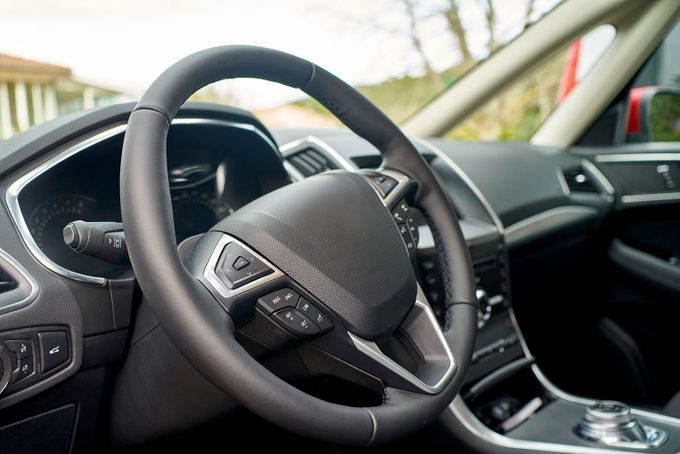
Have you ever touched a steering wheel that’s been baking in the sun? It’s not pleasant. The study published in Temperature reported that the surface temp of a steering wheel reached 127 degrees when a car was parked in the sun for one hour on a 100-degree day. Dashboards averaged 157 degrees and seats averaged 123 degrees.
A summer car tip to prevent any injury is to get a window heat blocker in your car. While the inside of your car will certainly still get warm, that steering wheel won’t be hot to touch when it’s time to head out.
How to protect yourself in the heat
Now you know to avoid a scalding hot steering wheel and limit any time your pup spends trotting on burning asphalt, but the heat is here to stay. And that means protecting yourself in other ways. The side effects of dehydration, heat exhaustion and heat stroke are serious.
Drink enough fluids
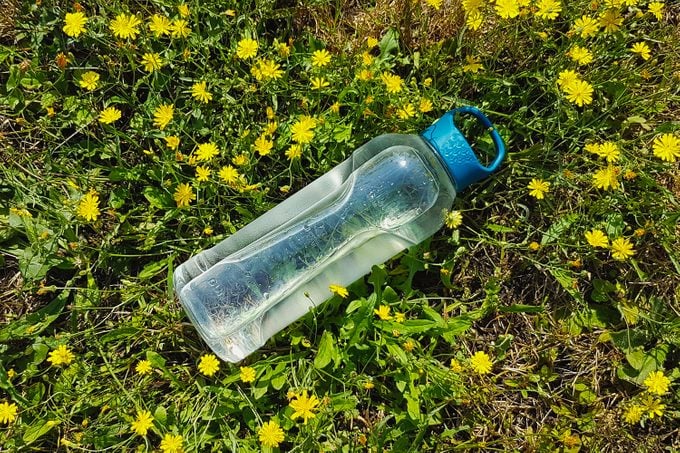
It’s easy to get dehydrated in extreme heat, and it can result in dizziness, weakness, fatigue, headache, dry skin, dry mouth and more. “The best way to measure your hydration levels is the frequency and color of your pee,” says Dana Cohen, MD, an advisor with Cure Hydration. “You should be getting up to pee every two to three waking hours, and if you’re not, you’re probably dehydrated.”
She also points out that the color of your urine can be another indicator. Urine should be straw-colored, not dark brown or orange. So pick the best reusable water bottle and get to drinking.
Add electrolytes
While drinking water is always good, replenishing yourself with electrolytes is a smart thing to do during crazy heat waves. “Replenishing electrolytes like sodium and potassium is key to ensuring the water you’re drinking is being absorbed into your cells,” says Dr. Cohen. “In fact, if you drink plain water all day, you actually risk losing electrolytes, as you’re flushing them out without replacing them.”
Take frequent breaks

Broccoli says that it may be wise to avoid strenuous outdoor activities for the time being. If this isn’t possible for your daily routine, he recommends taking frequent breaks to rest and rehydrate so you don’t have to deal with heat exhaustion. And be sure to head inside whenever possible. Set your thermostat to the best temperature for your house, or find ways to stay cool without an AC.
Walk on the grass
Because the sidewalks tend to radiate heat during rising temperatures, it isn’t the most comfortable to walk on during the height of the day—especially for your furry friends. Be sure to protect your dogs from heat stroke by taking them out earlier in the morning or later in the day and avoiding hot sidewalks or driveways if possible. Walk on the grass for a cooler experience, or protect your dog’s paws with a pair of booties. And consider a cooling dog bed to help them beat the heat.
About the experts
- Anthony J. Broccoli is a distinguished professor of atmospheric sciences at Rutgers University and co-director of the Rutgers Climate Institute.
- Dana Cohen, MD, is an integrated medicine practitioner with more than 20 years of experience. She has been at the forefront of integrative medicine and is a trusted health advocate and an advisor with Cure.
Sources:
- Axios: “‘Extreme’ heat envelops Phoenix, 42 million people under warnings”
- University of Georgia Cooperative Extension: “How hot does pavement get in summer?”
- Antiscald: “Burn Exposure Chart”
- Pool Furniture Supply: “How Hot Does Patio Furniture Get In The Sun?”
- Temperature: “Evaluating the impact of solar radiation on pediatric heat balance within enclosed, hot vehicles”
- Consumer Reports: “Hot Car Fatalities Are a Year-Round Threat to Children and Pets”
- National Institute of Standards and Technology: “Fire Facts”
- Arizona State University: “Study: Hot cars can hit deadly temperatures in as little as one hour”

